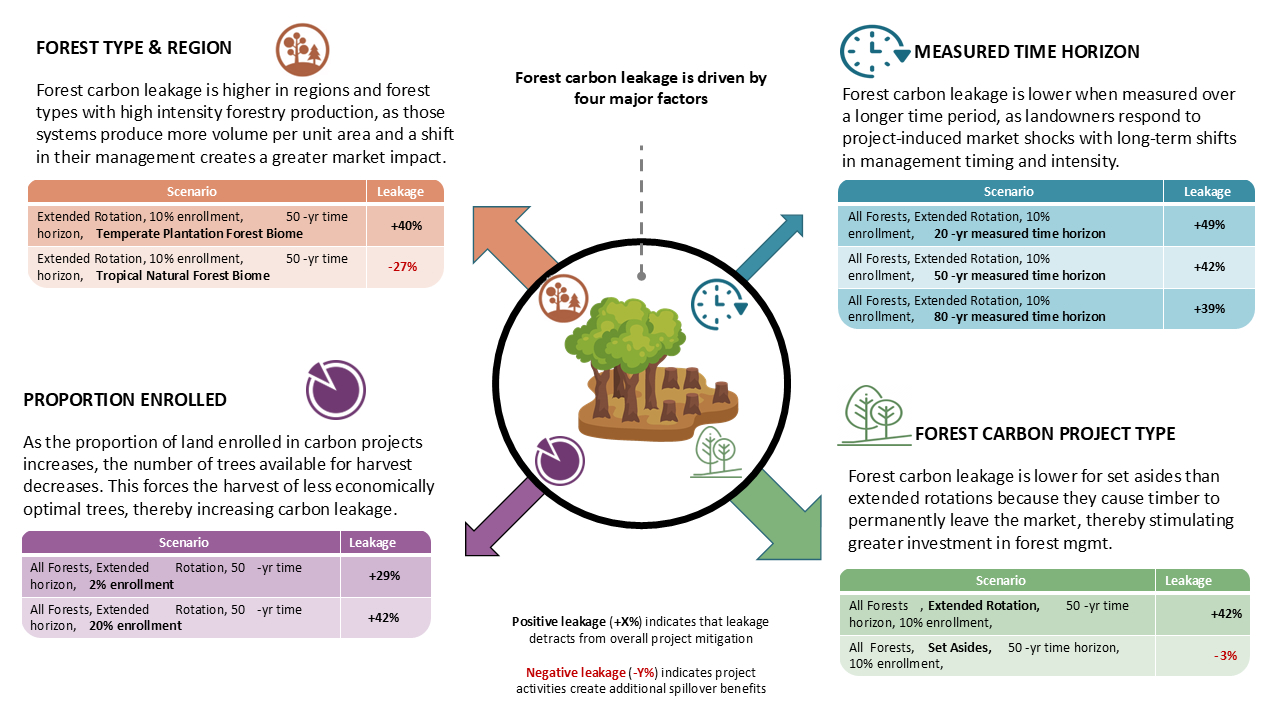A new global study led by TNC and collaborators reveals that carbon leakage from forest carbon projects is often lower than previously thought. The findings challenge current carbon market accounting practices and advocate for more nuanced, carbon-specific leakage estimates to ensure integrity and unlock greater investment in Climate Smart Forestry as a natural climate solution (NCS).
The Gist
Published in Environmental Research Letters, this study presents a globally applicable, data-driven approach to estimating carbon leakage from Climate Smart Forestry (CSF) practices (also known as Improved Forest Management), using the Global Timber Model (GTM).
When forests are protected or managed differently, timber harvesting can shift from inside a project to other forests outside the project. This shift, called “leakage,” affects the amount of carbon emissions that are actually mitigated. Traditional leakage accounting can misrepresent actual carbon impacts because it relies on simplistic harvest-based proxies that ignore the complex ecological and economic dynamics that influence actual carbon outcomes.
“This paper challenges current one-size-fits-all carbon accounting practices by modeling both harvest and carbon leakage across forest types, regions, and project designs,” notes co-author Ethan Belair, a senior forest carbon scientist at TNC. “Our results indicate that leakage is highly variable and often lower than we’d previously thought. The study emphasizes the need for robust, nuanced leakage accounting to ensure nature-based solutions are implemented with accuracy and integrity.”
The Big Picture
Forest-based NCS, particularly CSF practices like extended rotations and permanent set-asides, are critical to global climate change mitigation. However, concerns about leakage—where reduced harvesting in one area leads to increased harvesting elsewhere—have undermined trust in carbon markets, which often fund these practices.
Using GTM, a dynamic optimization model of the global forest sector, the authors simulate the effects of CSF projects on timber markets and forest carbon stocks. They analyze two main CSF interventions: extended rotations (delaying harvests) and set asides (permanently protecting forests). The model accounts for market-mediated responses, forest growth, and management changes across time and space.

Key Findings Include:
- Leakage varies widely depending on project type, forest biome, timeframe, and the proportion of landscape already implementing CSF practices.
- Extended rotations typically create positive carbon leakage, but that leakage is lower than previously thought.
- Set asides often produce lower leakage than extended rotations, due to stronger market signals encouraging conservation or enhanced forest management.
- Harvest leakage is a poor predictor of carbon leakage, highlighting the inadequacy of harvest-based metrics.
- Landscape context matters: New projects in landscapes with many existing CSF projects will have higher leakage than those in landscapes with few CSF projects.
The study identifies key drivers of leakage, including CSF implementation rate, forest species, and specific harvesting changes. Sensitivity analyses show that leakage estimates are relatively robust across different model assumptions.
The Takeaway
This paper offers a transformative perspective on how carbon leakage should be understood and measured in forest carbon projects. It challenges the conventional approach of equating carbon leakage with harvest leakage, arguing that using timber volume as a proxy can lead to significant overestimation of leakage and misguided policy decisions.
The authors emphasize that leakage is not a static phenomenon; rather, it is dynamic and highly contextual. Importantly, the paper highlights that when taking a nuanced, data-driven approach, leakage is often less impactful than previously thought.
To strengthen the integrity of carbon markets and promote effective forest-based climate solutions, the paper urges carbon registries and policymakers to adopt carbon-based leakage metrics. It recommends considering positive spillover effects and applying region-specific, multi-factor deductions. These changes, the authors argue, will not only improve market credibility but also encourage greater investment in CSF and ensure that forest carbon projects deliver real, measurable climate benefits.
In a push to integrate the best available science into CSF project design/carbon markets, the authors are already using these results with a variety of market actors to enhance the nuance, credibility, and accuracy of leakage accounting for IFM projects. That work includes a new leakage accounting tool for Verra’s VCS Standard and broader policy influence through UNFCCC’s Article 6.4 negotiations. The authors hope for additional collaborations with other registries, standards bodies, and others who want to apply the best available science to high-quality NCS projects.
This research was led by TNC and partners at the University of Maine and Ohio State University. The co-authors benefitted from deep collaborations and input from partners at TNC’s Global Carbon Markets team, the American Forest Foundation, TerraCarbon, and many others. This research was funded by the Bezos Earth Foundation, High Tide Foundation, Meta and private donors.



